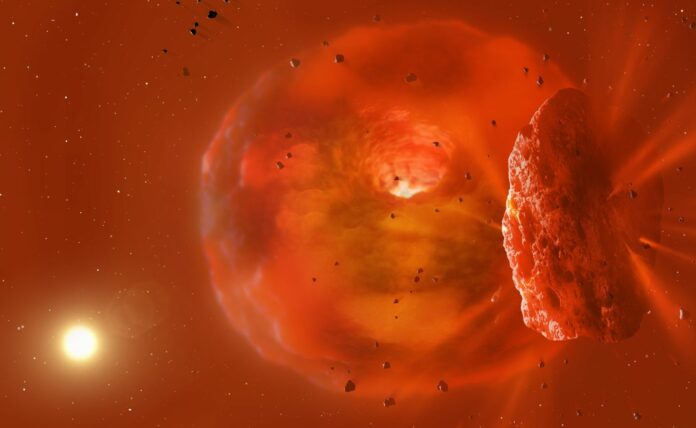Did Astronomers Just Witness the Most Epic Cosmic Collision Yet? Maybe, Yes
A new study published today in the journal Nature reveals an astonishing event: the collision of two massive ice exoplanets orbiting a star akin to our Sun. This cosmic clash emitted brilliant light and dispersed vast clouds of dust.
The research highlights the vivid thermal glow and subsequent dust formation, which eventually eclipsed its host star, causing it to dim progressively.
An international collective of astronomers came together following an intriguing observation by a space enthusiast. The data indicated a peculiar doubling in the star’s infrared luminosity approximately three years prior to its diminishing brightness in the visible spectrum.
Dr. Matthew Kenworthy of Leiden University, a primary author of the study, expressed his astonishment: “To be honest, this observation was a complete surprise to me. When we originally shared the visible light curve of this star with other astronomers, we started watching it with a network of other telescopes.
“An astronomer on social media pointed out that the star brightened up in the infrared over a thousand days before the optical fading. I knew then this was an unusual event.”
A combined group of seasoned and novice astronomers dedicated themselves to an in-depth study of the star, closely observing shifts in its luminosity for a subsequent couple of years. This star was named “ASASSN-21qj” in honor of the telescope array that first identified its reduced brightness in the visible spectrum.
After thorough analysis, the research team postulated that the most plausible reason for these observations was the collision of two vast ice exoplanets. This event resulted in an infrared luminescence, which was picked up by NASA’s NEOWISE mission, an initiative that utilizes space telescopes to track down asteroids and comets.
Dr. Simon Lock, a key researcher from the University of Bristol’s Earth Sciences department, stated, “Our calculations and computer models indicate the temperature and size of the glowing material, as well as the amount of time the glow has lasted, is consistent with the collision of two ice giant exoplanets.”
Following the impact, the ever-growing cloud of remnants moved across the star roughly three years afterward, leading to a noticeable reduction in the star’s observable brightness.
As time unfolds, it’s anticipated that the dust cloud will disperse along the collision’s trajectory. Intriguing patterns of light from this dispersal might soon be captured by both terrestrial telescopes and NASA’s premier space telescope, the JWST.
The team of astronomers is eager to continue their observations, keenly awaiting the star system’s forthcoming developments.
Posted by Revyuh on Wednesday, October 11, 2023
“It will be fascinating to observe further developments. Ultimately, the mass of material around the remnant may condense to form a retinue of moons that will orbit around this new planet,” added co-author Dr. Zoe Leinhardt from the University of Bristol.
Image Credit: Mark Garlick
